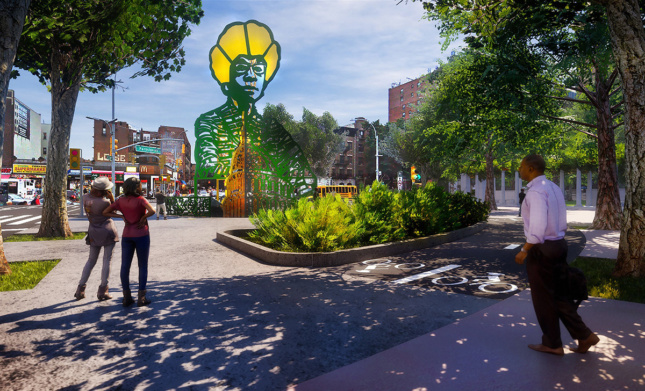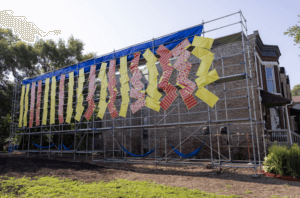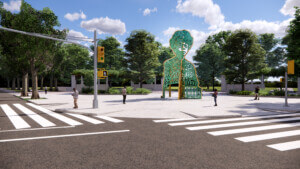A green and golden lace-like structure will soon stand 40-feet tall at the southeastern edge of Brooklyn’s Prospect Park. From one angle it will unveil the profile of a woman and from another, the outline of the U.S. Capitol dome. That’s the winning design for the monument dedicated to trailblazing Congresswoman Shirley Chisholm.
Created by artists Amanda Williams and Olalekan Jeyifous—both trained as architects—Our Destiny, Our Democracy was chosen among the top five proposals submitted through She Built NYC, the city’s new initiative to make more monuments dedicated to women throughout the five boroughs. The pair’s bold vision to honor Chisholm will be the first public project to be built through the program and is set to rise on the corner of Ocean Avenue and Parkside Avenues by late 2020.
AN spoke with Jeyifous, a Brooklyn resident himself, and Williams via email about how they came up with the striking memorial design and why it best embodies Chisholm’s spirit.

AN: How did you conceive of intertwining the image of the Capitol with Chisholm’s profile?
OJ + AM: It’s best described in our proposal: The U.S. Capitol dome figures prominently as a backdrop in many of her photographs. The strategy for our primary sculptural profile reverses this relationship so that her figure engulfs or embodies the dome iconography, thus claiming ownership.
This composite symbolizes how she disrupted the perception of who has the right to occupy such institutions and to be an embodiment for democracy…When approached from the park, a symbolic opening breaks through the capitol silhouette, creating a threshold that reinforces Chisholm’s fight to ensure that everyone could access their right to participate in the political process.
Not a basic bust or figure statue, why do you think this design best represents Shirley Chisholm and her legacy of “leaving the door open” for others?
We are not sculptors (in the most traditional sense of the word) so we knew that we would not be proposing a cast bronze representation of a figure. We are, however, trained in how to use space as a medium. We both bring that into our artistic practices in different but complementary ways. That proclivity toward space as an occupiable object inherently begs to be participatory and invites engagement. That seemed like a perfect analogy to Chisholm’s philosophy on democracy.
Making a sculpture commemorating this incredible political figure in our current climate is about remembering the long arc of democracy. Her words ring true because she was ahead of her time, but also because her philosophy was embedded in core values of inclusion and meeting people where they were in order to bring them into the process. We feel strongly that we have made a thoughtful and decisive piece that pushes the boundaries of what it means to embody the ideals of a person and not just their visage.

What are the connections or differences between the monument’s design and the traditional ironwork you might see in a gateway to a park?
The design is ultimately a threshold into what is a major urban park and that is reflected in the vine and leaf motif that weaves through the monuments tertiary sculptural profile. This was an intentional nod to the traditional garden gate typology. Now that we’ve been awarded the commission, we will begin the process of actually researching specifics and refining the design. We want to do a deeper review of the historic language of gates and thresholds associated with public parks, that material language for Prospect Park’s history, and then what we would want to add as new motifs.
In what ways do you foresee the sun playing a role in the way the monument is experienced?
We envision at certain vantage points the patinated and bronzed steel to be a glowing beacon and for the detailed filigree in the screens and perimeter fence to cast marvelous shadows on to the plaza surface. That the installation can be occupied contributes to the various ways in which light will transform the experience of visitors to the site. Shadows will also give it dynamism and whimsy as the sun angle changes by day and year. Its intensity is also something we hope to carry into night hours through the considered placement of lighting.











